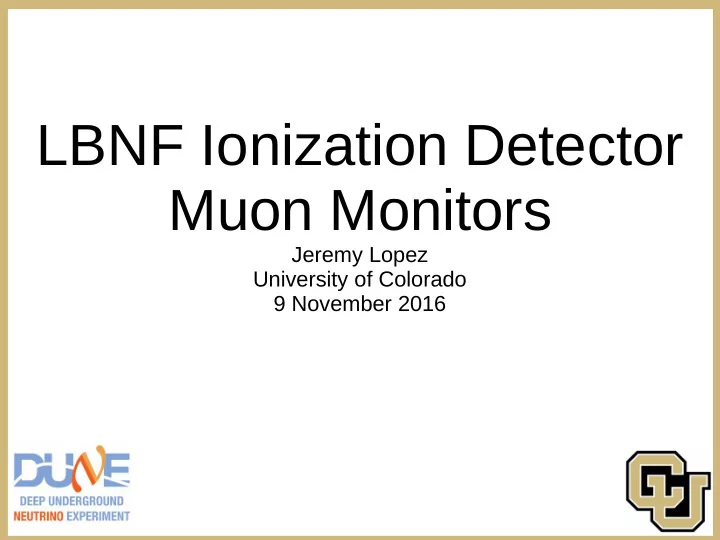

LBNF Ionization Detector Muon Monitors Jeremy Lopez University of Colorado 9 November 2016
LBNF Beamline Overview ND Target Decay Pipe Absorber & Muon Monitors Monitors downstream of absorber, upstream of ND Basically unlimited statistics. Measurements limited by: 1) Detector performance 2) Absorber geometry (energy threshold, profile shaping, etc) 11/09/16 Ionization Detectors 2
Muon Measurements pion neutrino muon Reference design: 1 large muon alcove Ionization detector array A single station for ionization detectors Get additional info from other detector types 11/09/16 Ionization Detectors 3
Possible Technologies: Gas Ionization Counters ● Used in T2K, NuMI, CNGS beamlines ● Simple design (parallel plates with voltage applied) ● Reliable, don't age much ● Gas needs to be refilled ● Slow signal development – not great for timing or studying beam substructure 11/09/16 Ionization Detectors 4
Possible Technologies: Diamond Detectors ● Have been used in T2K, CNGS beamlines but not in main muon monitor array ● Very fast signals – good timing ● May be less susceptible to pileup ● More rad hard than other solid-state detectors ● Very expensive – can save some money by producing detectors ourselves 11/09/16 Ionization Detectors 5
Possible Technologies: Silicon Photodiodes ● Used in T2K beamline ● Have many of the same advantages as diamond ● Need to be replaced fairly often ● Commercial device ● Low cost 11/09/16 Ionization Detectors 6
LBNF vs Other Beamlines ● 12.5 x 10 12 POT / bunch, 6 bunches / spill ● Muon rate in alcove ~ 10x NuMI alcove 1 and 2x T2K (at design power) – Detectors must deal with harsher environment, larger signals – How will this affect signal linearity? – How long will detectors last? 11/09/16 Ionization Detectors 7
Tests in NuMI Alcove ArXiv:1507.06690v2 Placed detectors in alcove 2 12 m or rock behind hadron absorber Muon rate ~ 1/4 that of alcove 1 11/09/16 Ionization Detectors 8
Diamonds in Alcove 2 ● 3 diamonds placed behind alcove 2 muon monitor ● Cividec detectors, previously used in CNGS ● Data taken from Spring 2015 until present (work ongoing) Diamonds 11/09/16 Ionization Detectors 9
Diamond Detector Signal 6 batches 11/09/16 Ionization Detectors 10
Zoom in on Signal 53 MHz bunches 11/09/16 Ionization Detectors 11
Some Initial Results ● All work in progress – Signal linearity – Resolution – Gain drift after detector HV turn on – Year-to-year gain variation – Signal shape 11/09/16 Ionization Detectors 12
Signal Linearity Good Statistics: Poor Statistics: Steady Beam Many single shots Work in Progress DUNE April & May 2016 11/09/16 Ionization Detectors 13
Signal Linearity Work in Progress DUNE April & May 2016 ● Nonlinearity <1% in region with good statistics ● ~4% looking over full data set 11/09/16 Ionization Detectors 14
Resolution May & June 2016 POT > 4x10 13 Work in Progress DUNE ● Gaussian fit: σ=0.3% ● RMS: 0.4% ● Ignoring nonlinearity & long term gain drift: – Resolution much better than 1% for a single detector 11/09/16 Ionization Detectors 15
Neutrino/Antineutrino Ratio ● Antineutrino to 2016 neutrino signal ratio Diamond Signal / POT is: 0.67±0.02 Work in Progress ● Detector and DUNE alcove simulation with G4NuMI input: 0.68±0.03 (muon flux only, no energy loss) 11/09/16 Ionization Detectors 16
Turn-On Effects: Short Term Diamond Signal / POT [arb. units] Gain quickly increases when detector HV turned on Work in Progress DUNE ● After turning detector off for a weekend, see gain rapidly increasing & then settling over first hour or so 11/09/16 Ionization Detectors 17
Turn-On Effects: Long Term 2016 Diamond Signal / POT [arb. units] Work in Progress DUNE ● Signal/POT continues to increase by several % over ~1 month after turning detector on 11/09/16 Ionization Detectors 18
Year to Year Variation Diamond Signal / POT [arb. units] Diamond Signal / POT [arb. units] 2015 2016 Work in Progress Work in Progress DUNE DUNE ● Note: Negative signals ● Gain settles on different value: 2% drop from 2015 to 2016 ● Will this continue? Should continue if due to detector aging effects 11/09/16 Ionization Detectors 19
Signal Shape ● Shape doesn't perfectly match Signal per bunch [arb. units] proton signal Signal ramps up ● Significant fraction of signal seems to be associated with Work in Progress ~2 μs decay DUNE Long decay – Muon Slip stacking first 2 batches capture/decay? – Materials activation? – Electronics? 11/09/16 Ionization Detectors 20
Hardware Work ● Have some silicon photodiodes ● Put in alcove 2, may help resolve questions about signal shape ● Working on building a diamond detector from a bare diamond at CU ● May be much more cost-effective than prepackaged detectors ● New diamond, different electronics – see how performance compares to commercial devices 11/09/16 Ionization Detectors 21
Conclusions ● Muon monitoring at LBNF will be more challenging than at existing beams due to much larger fluxes ● Solid-state detectors offer many possible advantages over more standard gas detectors, but also may have some drawbacks ● We have experience operating detectors in a beamline, are working on constructing our own detectors to test at NuMI 11/09/16 Ionization Detectors 22
Recommend
More recommend